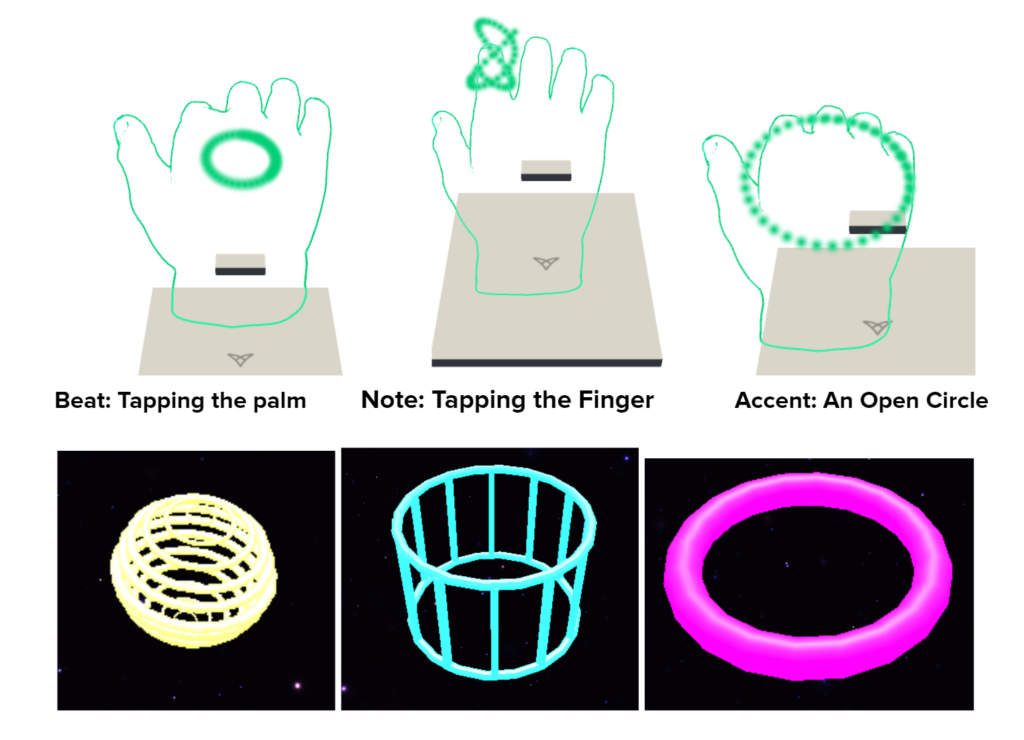This week, we divided our group into two teams, one team focused on the development of music prototypes and the other team focused on the design of Reinforcement Machine Learning prototypes. We finished the development of the music prototype by Thursday and we conducted the playtest for this prototype on Friday.
Sprint 2 – Feeling the Music
Last week, we finished the basic function for the prototype, so this week we mainly focused on the UI and visualized the notes, beat, and accent.
First, we decided to show a transparent hand on the screen so that the user can see how beats, notes, and accent hit their hand.
Also, we want the haptic feeling matched with the visualization of beat, note, and accent on the screen. Here is a comparison of the haptic feeling and the model of beat, note, and accent.

In addition, we designed 5 buttons. Three buttons are the switch of turning on or turning off the beat, note, and accent. One button is for changing to the next song. One button is to change the theme of the game. By using these buttons, the user can finish all the interactions just by using their hand.
We designed two different themes. One is a dark background and bright gloomy object style. Another is a white background. The User can change the background by pressing the theme button.
Finally, we also designed three tutorial levels to let the user feel the beat, note, and accent separately. We choose some very simple beats and melodies so that the user can have a better understanding of our prototype. The user can also learn how to press buttons through the tutorial.
Here is our demo video:
Playtest
We organized a playtest on Friday at ETC. There were 21 people in total participating in the playtest. The total playtesting time is about 15 minutes for each playtester, 10 minutes for playing the prototype, and 5 minutes for filling in the questionnaire. Also, since Ultrahaptic is a novel device, we are worried that the engagement mainly comes from the new device. We decide that after the players finish the tutorial, we will hide all the visual representations of beats, notes, and accents for 30 seconds to test if the visual representation really helps to improve the overall experience.
We decided to conduct two playtests for this prototype. The first playtest focuses on engagement. The second playtest focuses on the understanding of the music. Therefore, for the first playtest, our specific hypothesis is that novelty of interaction can enhance the level of interest. We came up with two metrics to measure engagement, one is curiosity. Is there any wow moment for the experience? And does the experience raise users’ curiosity? The second metric is interactivity. What is the total time the user plays? How many times do they play?
Based on the hypothesis, we designed a questionnaire. The questions are mainly about the overall experience, the visual representation of the music, the haptic feeling, the theme, and the UI design.
We analyzed the feedback from the playtest carefully. Here is our conclusion.
The novelty of interaction can enhance the level of interest
Visual communication allows people to receive information more effectively
Sprint 3
We also got two more specific ideas for sprint 3. Our overall goal is to virtualize the process of Reinforcement Learning. We will decide which direction we will go next week.
The first idea is about AI randomly placing prefabricated creatures to create an environment. The AI controls the behavior of the creatures. The user will judge if the creatures’ behavior is reasonable. The AI will regenerate the creatures’ behavior based on the user’s feedback.
The second idea is about Procedural Generation. The player acted as a dinosaur. The player can interact with the environment to give them positive feedback or negative feedback. The environment will change based on the player’s feedback. For example, if the player loves cabbage, the cabbage’s credit and farm products’ credit will become higher. There will be more cabbage and farm products in the environment.